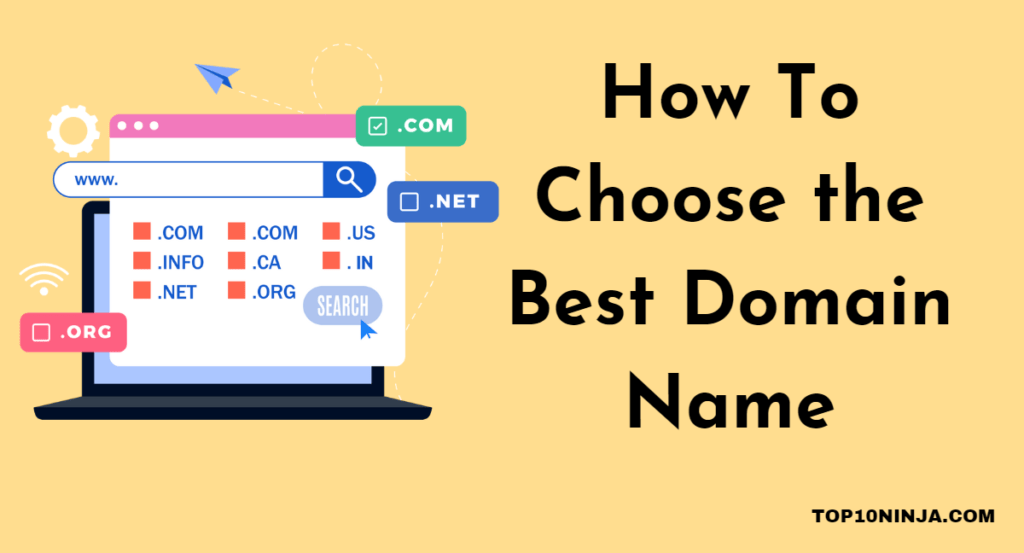Choosing the best domain name can be stressful because you don’t want to make a mistake. Follow our tips if you are also wondering how to choose a domain name that suits best your business.
Your first real digital task in creating a new blog is to register your domain name.
And if you’re planning to toss this one off with no planning, or worse yet, just take whatever random second-tier domain WordPress.com assigns you, please hold up for a moment.
In the time it takes to read this article, you’ll understand why that’s a very bad idea.
Because honestly, this is one decision you do not want to get wrong. And it’s harder than it might seem.
But first, let’s make sure we’re all speaking the same language.
How To Choose A Domain Name in 2023

What’s a Domain?
Hey, there are no stupid questions here. Your domain is the address of your blog. For example, our domain is blogging.com. Google’s is google.com.
You can have a top-level domain — like the examples in the preceding paragraph — or a second-level domain, such as randomblog.wordpress.com. You can also have a subdomain such as mywebsite.com/randomblog – in that case, /randomblog is a subdomain of the top-level domain, or TLD, mywebsite.com.
Got it? Good. Let’s move on to the fun stuff.
Why Domains Are Important
Your domain is important because it’s one of the first marketing or branding elements your prospects will ever see. It forms part of the first impression they’ll have of you, your site, and your brand.
While it’s not impossible to transfer a site later, it will take time and money. It’s also a somewhat complicated and involved task, and it’s easy to make a mistake and mess things up.
There’s also the SEO issue to consider. If you change domains, you lose the SEO juice you’ve built up for that domain over time.
So save yourself the drama and make a strategic, considered decision from the outset.
How Domains Work
When you grab your domain, you won’t actually be “buying” a domain. That’s because no one really “owns” domains, at least not in the sense we usually think about the concept of ownership.
Instead, think about it like this: you’re basically renting the right to use a domain exclusively (ie, no one else can use it during that time) for one or more years.
That being said, domains are transferred (usually in exchange for cash payments) all the time. So you’ve got a few different options when it comes to acquiring your domain:
- The vast majority of domains are simply registered directly from registration companies such as GoDaddy and the like.
- You can reach a private transaction agreement with the registered domain holder in which you pay them some cash and they transfer you the domain rights.
- You can grab a domain by successfully outbidding other bidders at an auction.
Types of Domains (and Which One You Want)
Domains have different kinds of extensions for TLDs — a lot of different kinds of extensions. Of course, the digital world has expanded dramatically since the days when your choices were restricted to .com, .org, and .net.
Now, you can choose a ccTLD (country code, or nation-specific) TLD, such as .al for Albania or .de for Germany. But you can also choose from a whole host (pardon the pun) of specialty domains as well, like .accountant or .blackfriday or even .blog.
With all this rich bounty of domain extensions from which to choose, how is a new blogger ever to make a decision?
Pick .com, always.
Why? Simple. It’s the most well-known of all the TLDs. And as the most popular TLD, .com has reached the point where all web-literate users are familiar with it. It’s accessible to all of us. We know what it means.
If .com isn’t available for a domain you simply must have, you can consider .net, .info, .co, or .blog. Or maybe pick another domain.
Qualities of a Good Domain Name
What makes a domain name a good choice? Briefly, it’s a domain that is:
- Memorable (which means short)
- Easy to type (contains no numbers or hyphens)
- For local businesses, references the area (town, state, etc).
It’s essential to keep your domain name short – one to two words if possible. The top 50 most popular websites have an average of six characters in their domain name. Short means memorable and easy to recall.
Keep it easy to pronounce and spell, too. Pronounceable means that your users will also be more likely to recall and type it incorrectly.
To nail this, try a simple test: speak your domain name out loud to ten different people and ask them to write it down to see how they think it should be spelled. Good names are easy to figure out and the more people who get it right, the more confident you can be that others will, too
Make it unique by combining two short words together (Go + Daddy, Face + Book), altering the spelling of common words (Toggl, Google), add suffix or prefix to a word (Shopify), or coining any entirely new word (Vimeo).
What Comes First: Domain or Brand Name?
Your domain name needs to match your brand. It’d be nice to grab a short, keyword-rich domain without spending a lot of money in an auction or transfer, but it’s unlikely. That means a brand-related domain.
You can name your brand and then look for the domain, or you can brainstorm a few names and pick your brand based on what domains are available.
Either approach is perfectly reasonable. Just make sure you don’t invest heavily in a brand’s marketing until you know the domain that goes with it (the one you’re depending on) is available and yours.
A brandable “sound” is important. This is admittedly a concept that’s hard to define, but most folks can spot the neighborhood when they’re driving by it.
A word of caution is warranted here: Avoid trademark infringement at all costs. The question isn’t whether you’d get confused between your domain and another business’s domain.
It’s whether a judge would think some mythical person might get confused. You don’t want to risk everything you’re about to work so hard for on a question like that.
Tools to Help You Brainstorm the Best Domain Name
Domain name generators may well be your very best buddy during this process. Consider sites like:
Create a list of possibilities, using those tools if you like. A spreadsheet is a good option here. Add columns for budget and availability of the domain, too.
Analyzing Your Choices
Once you’ve got a ranked list of available or possibly-available domains, go visit each of them in turn. That means enter each into your browser address bar and see what happens.
If it’s “not found” or nothing pops up, congratulations! It very well may be available, in which case for $15 or so at your registration site of choice, it’s yours.
If it shows up as an active page, you might be able to grab it if you make an offer that’s high enough — but this is usually not successful unless you can throw a lot of money at the present user. And by “a lot of money,” we mean thousands of dollars.
If it shows up as an “under construction” page, it could actually be under construction, or maybe the owner has no idea what to do with it.
You could make an offer, and you’ll probably end up paying something less than if it were an active page, but — again — much more than if you registered it outright.
Once you’ve whittled down your list to the domains you want to purchase, you can upload them to a registration site.
Another option for finding domains you love is to explore auction sites such as Sedo and GoDaddy Auctions.
But what if the domain you want is active or held by a squatter, but you really want to try to get it? First, you’ll need to locate contact info for the registered owners. Look for a “this site may be for sale” link and accompanying information, or use “who is” informational tools to find the registered owner.
If contact information is listed, use it. If not, you can try contacting the proxy registrant. Sometimes this works. But many times, you’ll never hear another word.
In your first email, you’ll simply want to inquire whether the domain might be available for transfer. Don’t make an offer right off the bat. Just ask if it’s available.
Always consider valuation before you make an offer or entertain a price. Shorter domains will be more expensive, while domains including fillers such as “the” or “my” should go for less.
You can learn more on how to value a domain or use a valuation tool like SitePrice.com or EstiBot.
One last avenue for snatching up a great domain is to monitor domains that are expiring, then grab them once the registration lapses.
Sites like NameJet, Snapnames, and GoDrops can help you monitor and identify these kinds of opportunities. You’ll pay more than the random first-time domain registration at GoDaddy, but it might be worthwhile.
Get a Top-Level Domain (TLD) for Free
Yes, I mean it. You can get a top-level domain of your choice, (.com, .net, .org or similar) for free.
In all honesty, there are no tricks, except for selecting your hosting provider wisely. Some hosting providers include free domains in the introductory offers, such as:
- InMotion Hosting
- GreenGeeks (first year free)
- LiquidWeb (only with a Dedicated Server Plan)
- Bluehost (Free for first year)
Launching on the Right Foot
By selecting your ideal domain name from the outset, your blog is much more likely to succeed than one that starts out with your third or fourth pick.
So it pays (quite literally) to do the research upfront. Best of luck!




